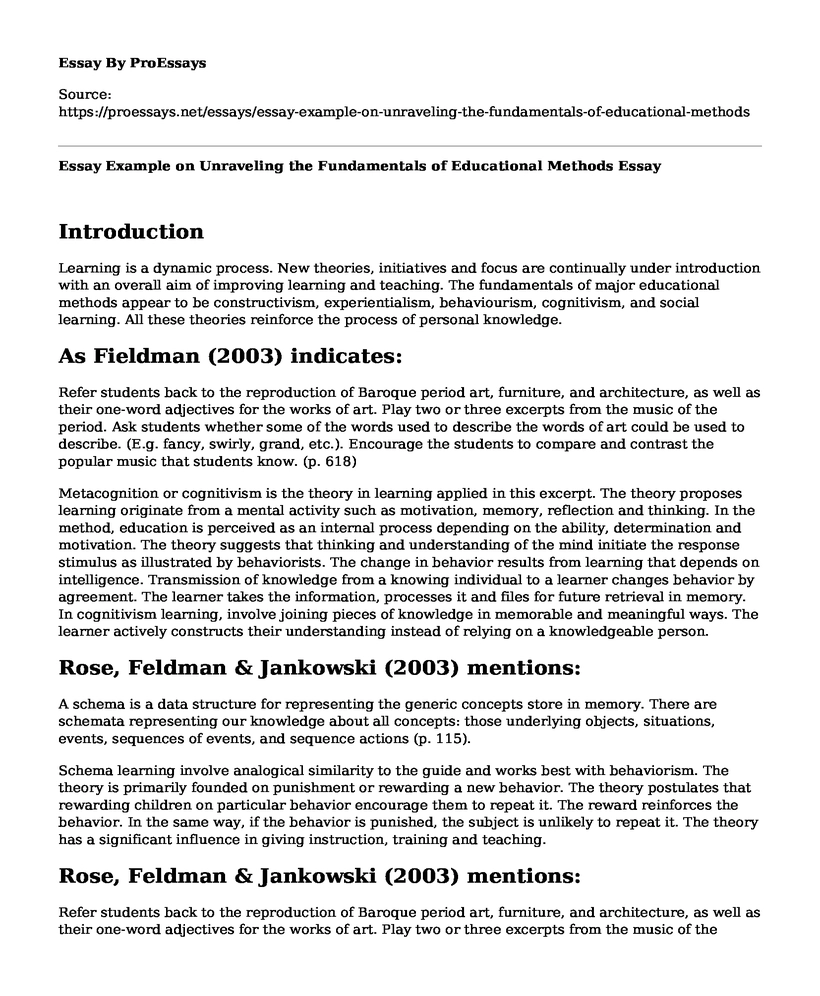Introduction
Learning is a dynamic process. New theories, initiatives and focus are continually under introduction with an overall aim of improving learning and teaching. The fundamentals of major educational methods appear to be constructivism, experientialism, behaviourism, cognitivism, and social learning. All these theories reinforce the process of personal knowledge.
As Fieldman (2003) indicates:
Refer students back to the reproduction of Baroque period art, furniture, and architecture, as well as their one-word adjectives for the works of art. Play two or three excerpts from the music of the period. Ask students whether some of the words used to describe the words of art could be used to describe. (E.g. fancy, swirly, grand, etc.). Encourage the students to compare and contrast the popular music that students know. (p. 618)
Metacognition or cognitivism is the theory in learning applied in this excerpt. The theory proposes learning originate from a mental activity such as motivation, memory, reflection and thinking. In the method, education is perceived as an internal process depending on the ability, determination and motivation. The theory suggests that thinking and understanding of the mind initiate the response stimulus as illustrated by behaviorists. The change in behavior results from learning that depends on intelligence. Transmission of knowledge from a knowing individual to a learner changes behavior by agreement. The learner takes the information, processes it and files for future retrieval in memory. In cognitivism learning, involve joining pieces of knowledge in memorable and meaningful ways. The learner actively constructs their understanding instead of relying on a knowledgeable person.
Rose, Feldman & Jankowski (2003) mentions:
A schema is a data structure for representing the generic concepts store in memory. There are schemata representing our knowledge about all concepts: those underlying objects, situations, events, sequences of events, and sequence actions (p. 115).
Schema learning involve analogical similarity to the guide and works best with behaviorism. The theory is primarily founded on punishment or rewarding a new behavior. The theory postulates that rewarding children on particular behavior encourage them to repeat it. The reward reinforces the behavior. In the same way, if the behavior is punished, the subject is unlikely to repeat it. The theory has a significant influence in giving instruction, training and teaching.
Rose, Feldman & Jankowski (2003) mentions:
Refer students back to the reproduction of Baroque period art, furniture, and architecture, as well as their one-word adjectives for the works of art. Play two or three excerpts from the music of the period. Ask students whether some of the words used to describe the words of art could be used to describe. (E.g. fancy, swirly, grand, etc.). Encourage the students to compare and contrast the popular music that students know.
The excerpt illustrate transfer theory. This type of learning does not entail a response to a stimulus but reflection and abstraction through the development of conceptual structures and self-regulation. The theory indicates learning involves interpretation from previous experience and personal perspective. Learning is through observing, processing and interpreting, followed by personalization of the information into knowledge. Another aspect of constructive learning is situated learning that utilizes the beliefs and conceptions of education.
Rose, Feldman & Jankowski (2003) mentions:
Show a reproduction of Bernard van Riesnburgh's Desk...Provide each student with the student handout 'My Ultimate Desk' a student journal on page 1 of their student journals, have the students draw a picture of their own 'ultimate desk'. On page 2 of their journals, have them write a description of their desk and compare it to the Double desk (p. 119).
The process of learning to draw involves the experiential learning theory. The theory indicates deriving knowledge from experiences that entails adequate perception and dispensation of experiences leading to enhanced performance (Bransford & Brown, 2000). The method involves problem solving by the imitation of backgrounds, skill demonstration, application and incorporation of the abilities to the real word experience. In other words, learners put effort into doing something, reflect on it, identify its key points and relate them in life and work.
Lastly, Social learning involves the attainment of knowledge between people interacting. The environment of such learning consists of a community or group of individuals. The passing of knowledge and information is through observation, been in a team or part of a larger group that include peers of colleagues in different experience levels for each other's progress. The learning method involves the learner, people near them, equipment used and technologies in use as well as the overall culture at the workplace.
References
Bransford, J. D., & Brown, A. L. Cocking, A. (2000). How People Learn: Brain, Mind, Experience, and School. Expanded Edition.
Rose, S. A., Feldman, J. F., & Jankowski, J. J. (2003). The building blocks of cognition. The Journal of pediatrics, 143(4), 54-61.
Varotsis, G. (2019). The role of plotting and action schemata in the consolidation of narrative information in dramatic writing. New Writing, 1-17.
Cite this page
Essay Example on Unraveling the Fundamentals of Educational Methods. (2023, Feb 27). Retrieved from https://proessays.net/essays/essay-example-on-unraveling-the-fundamentals-of-educational-methods
If you are the original author of this essay and no longer wish to have it published on the ProEssays website, please click below to request its removal:
- Linguistic Principle Explaining to the Local Group of ASL Teachers
- Working Memory as a Remembrance of a Reward: Do Children Recall Shapes When Given a Reward?
- Classroom Observation: Garrett Case Study Paper Example
- Essay on Observation of Classroom Dynamics at University
- Essay on Importance of ICT in Education
- Life Events and Future Goals: A 25-Year-Old's Journey - Essay Sample
- Chimamanda Adichie's Journey from Nigeria to America: Education, Privilege, and Experience - Essay Sample







